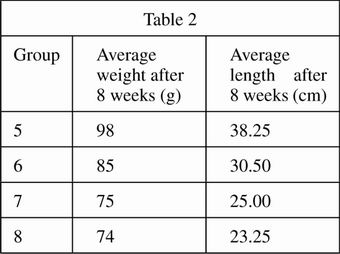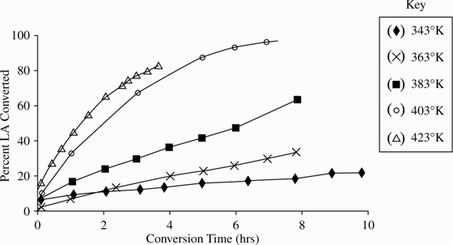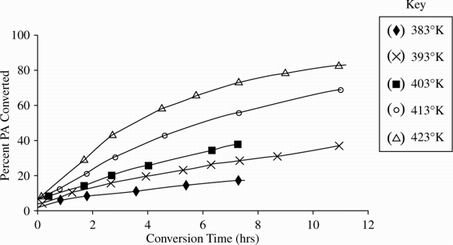ACT Science Practice Test 59
Bộ sưu tập: Tuyển Tập Bộ Đề Thi Đại Học Hoa Kỳ (ACT) - Có Đáp Án Chi Tiết
Số câu hỏi: 12 câuSố mã đề: 1 đềThời gian: 1 giờ
214,195 lượt xem 16,469 lượt làm bài
Bạn chưa làm đề thi này!
PASSAGE IV
Students wanted to test the effects of nutrition on the growth of guinea pigs. Two experiments were conducted using different feeds and vitamin supplements. For both experiments, four groups of 10 guinea pigs each were given a different type of feed over an 8-week period. Each group received the same quantity of food and was provided with fresh water daily. The guinea pigs were measured and weighed weekly. The guinea pigs in each group had an average starting weight of 50 grams (g) and an average starting length of 20 centimeters (cm).
Experiment 1
Group 1 was fed a high-protein feed (Feed P).
Group 2 was fed a grain-based feed with vitamin supplements (Feed Q).
Group 3 (control group) was fed a grain-based feed without supplements (Feed R).
Group 4 was fed a grain-based feed without supplements plus
fruits and vegetables (Feed S).
The results and average measurements are recorded in Table 1 below.

Experiment 2
Group 5 was fed a high-protein feed plus fruits and vegetables (Feed V).
Group 6 was fed a grain-based feed with vitamin supplements plus fruits and vegetables (Feed W).
Group 7 (control group) was fed a grain-based feed without supplements (Feed X).
Group 8 was fed a grain-based feed without supplements plus fruits only (Feed Y).
The results and average measurements are recorded in Table 2 below.

Based on the results of the experiments, which feed resulted in the greatest weight gain?
Feed
Feed
Feed
Feed
Based on the results of Experiment 1, the guinea pigs in the group that was fed a grain-based feed with vitamins gained how much weight, on average, during each week of the experiment?
29 grams.
11 grams.
10 grams.
4 grams.
If the students added vitamin supplements to Feed V for a new group (Group 9), what might the result be after 8 weeks?
The guinea pigs in Group 9 would weigh less than those in Group 5.
The guinea pigs in Group 9 would weigh less than those in Group 6.
The guinea pigs in Group 9 would have a greater average length than those in Group 5.
The guinea pigs in Group 9 would have a shorter average length than Group 6.
Which of the following statements is true, according to Table 2?
Feed W produces guinea pigs that are almost twice as long as those in the control group.
Feed V produces guinea pigs that weigh three times as much as those in the control group.
Feed Y produces guinea pigs with the greatest average length.
Feed X produces guinea pigs similar to those produced by Feed
From the results of the experiments the students would hypothesize that the guinea pigs in Groups 3 and 4 are similar because:
the control group was fed larger quantities of food.
the fruits and vegetables given in Experiment 1 did not have a very high nutritional value.
neither group received enough high-protein food.
the vitamin supplements given in Experiment 2 were more potent than those given in Experiment 1.
According to the passage, the guinea pigs in which of the following groups showed the least overall growth?
Group 8.
Group 7.
Group 4.
Group 1.
PASSAGE V
Students studied the effect of temperature on the conversion rates of two organic acids to their corresponding alcohols. The two organic acids studied were lactic acid (LA) and propionic acid (PA). Each acid was mixed with an Ru/C catalyst (to start the conversion) in an aqueous (water) solution. Lactic acid was found to break down into propylene glycol (PG), water, and various carbon side products. Propionic acid was found to break down into 1-propanol (1-PrOH), water, and various carbon side products. For all experiments, temperature was measured in degrees Kelvin (K).
Experiment 1
Students mixed an LA concentration of 0.5 moles (M) in a 50-milliliter (ml) aqueous solution along with a 5% Ru/C catalyst. The temperature was then varied to study the effect on the rate of conversion from lactic acid to PG. The results are shown in Figure 1.

Figure 1
Experiment 2
Students mixed a PA concentration of 0.5 M in a 50 ml aqueous solution along with a 5% Ru/C catalyst. The temperature was then varied to study the effect on the rate of conversion from propionic acid to 1-PrOH. The results are shown in Figure 2.

Figure 2
According to Figure 1, after two hours at 403°K, the percent of LA converted was closest to which of the following?
10%
50%
80%
100%
According to Figure 1, at 423°K, the greatest percentage of conversion occurred during which of the following time intervals?
8 to 10 hours.
6 to 8 hours.
2 to 4 hours.
0 to 2 hours.
Which of the following was held constant in each of the experiments?
The amount of catalyst used.
The temperature.
The conversion rates.
The type of acid used.
Based on the data in Tables 1 and 2, which of the following best describes the results of the experiments? As conversion time increased, the percent of acid converted:
decreased at some temperatures only until conversion stopped.
increased at some temperatures only until conversion stopped.
decreased at all temperatures until conversion stopped.
increased at all temperatures until conversion stopped.
A chemist claimed that the propionic acid conversion rate at 403°K dramatically increases between 8 and 12 hours. Do the results of the experiments support this claim?
No; according to Figure 2, conversion stops after 8 hours and does not reach 100%.
No; according to Figure 1, nearly 100% of the acid has been converted after 8 hours.
Yes; according to Figure 1, there is a significant increase in the conversion rate after 8 hours.
Yes; according to Figure 2, less than 50% of the acid has been converted after 8 hours.
Based on the results of Experiment 2, assuming that conversion of PA at 423°K continued until it reached 100%, one could predict that 100% of the PA would be converted during which of the following time intervals?
< 2 hours.
4 to 6 hours.
12 to 14 hours.
< 12 hours.
1 mã đề 55 câu hỏi
1 mã đề 23 câu hỏi
1 mã đề 10 câu hỏi
1 mã đề 24 câu hỏi
1 mã đề 22 câu hỏi
